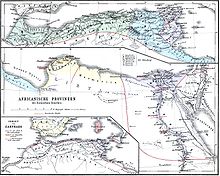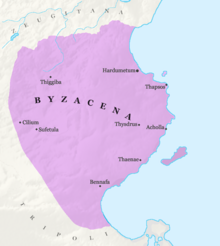

| Provincia Byzacena ἐπαρχία Βυζακινῆς | |||||||||||||
|---|---|---|---|---|---|---|---|---|---|---|---|---|---|
| Province of the Late Roman Empire - Byzantine Empire | |||||||||||||
| 293–439 534–698 | |||||||||||||
 Map of Roman Africa and Egypt; Byzacena shown in top right. | |||||||||||||
 The Province of Byzacena, showing its territorial extent, capital and major cities. | |||||||||||||
| Capital | Hadrumetum | ||||||||||||
| Historical era | Late Antiquity - Early Middle Ages | ||||||||||||
• Division by Diocletian | c. 293 | ||||||||||||
| 439 | |||||||||||||
• Byzantine reconquest by Vandalic War | 534 | ||||||||||||
• Reorganization into the Exarchate | 591 | ||||||||||||
| 698 | |||||||||||||
| |||||||||||||
| Today part of | Tunisia | ||||||||||||
Byzacena (orByzacium) (Ancient Greek: Βυζάκιον, Byzakion)[1] was a Late Roman province in the central part of Roman North Africa, which is now roughly Tunisia, split off from Africa Proconsularis.
At the end of the 3rd century AD, the Roman emperor Diocletian divided the great Roman province of Africa Proconsularis into three smaller provinces: Zeugitana in the north, still governed by a proconsul and referred to as Proconsularis; Byzacena to its adjacent south, and Tripolitania to its adjacent south, roughly corresponding to southeast Tunisia and northwest Libya. Byzacena corresponded roughly to eastern Tunisia or the modern Tunisian region of Sahel.
Hadrumetum (modern Sousse) became the capital of the newly made province, whose governor had the rank of consularis. At this period the Metropolitan Archbishopric of Byzacena was, after the great metropolis Carthage, the most important city in Roman (North) Africa west of Egypt and its Patriarch of Alexandria.
Ancient episcopal sees of Byzacena listed in the Annuario Pontificioastitular sees:[2]
|
Late Roman and early Byzantine provinces (4th–7th centuries AD)
| |||||||||||||||||||||||||
|---|---|---|---|---|---|---|---|---|---|---|---|---|---|---|---|---|---|---|---|---|---|---|---|---|---|
| |||||||||||||||||||||||||
| |||||||||||||||||||||||||
| |||||||||||||||||||||||||
| |||||||||||||||||||||||||
| |||||||||||||||||||||||||